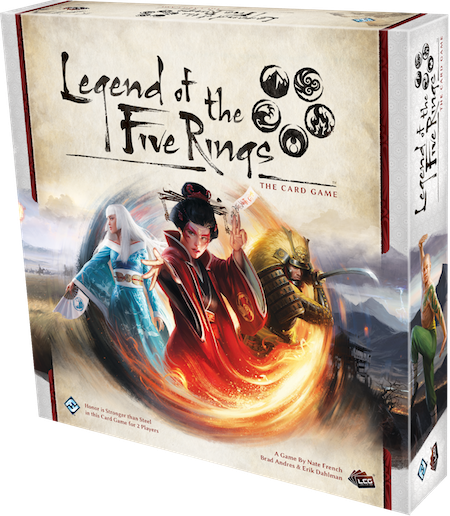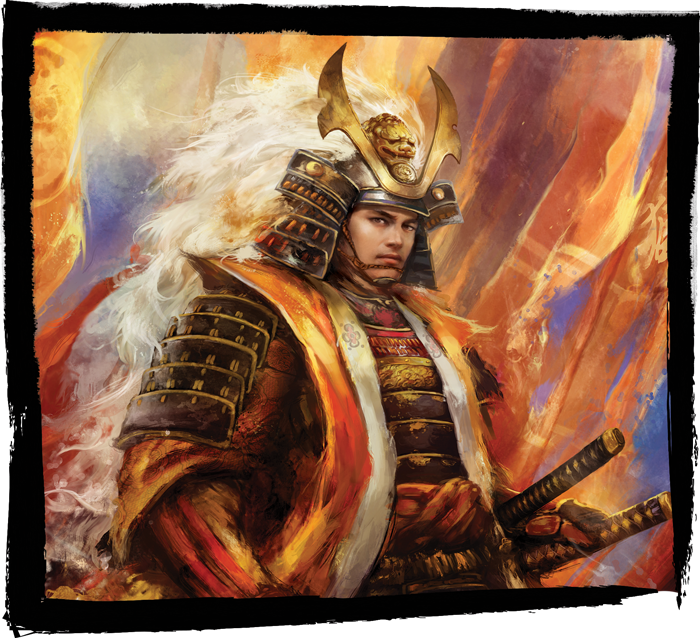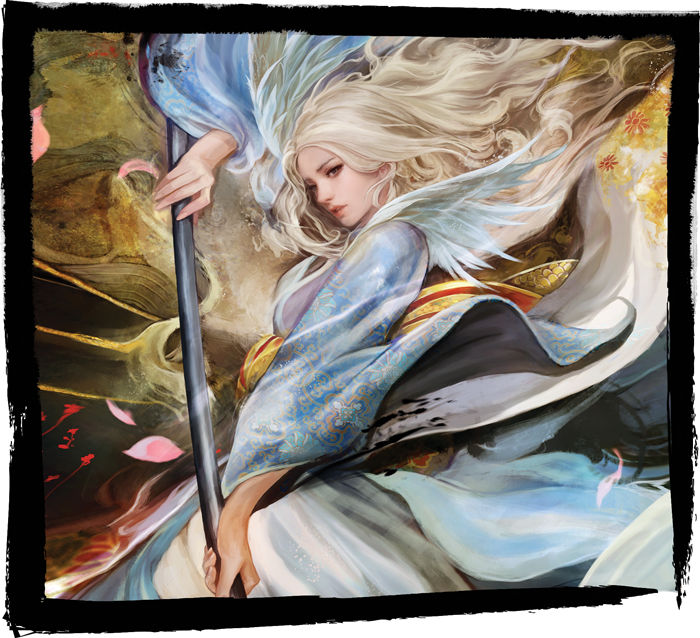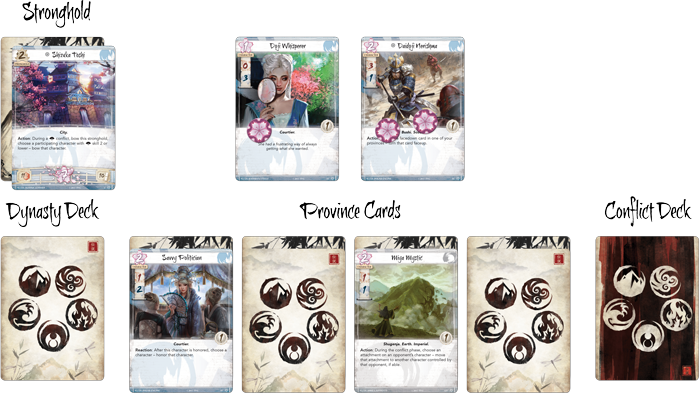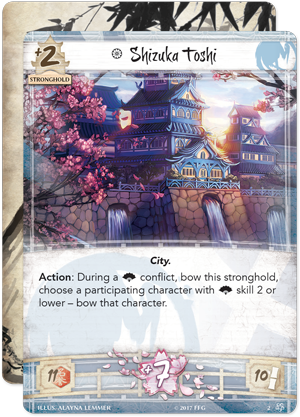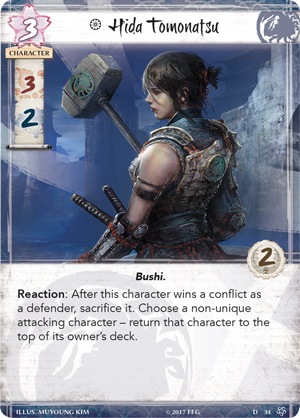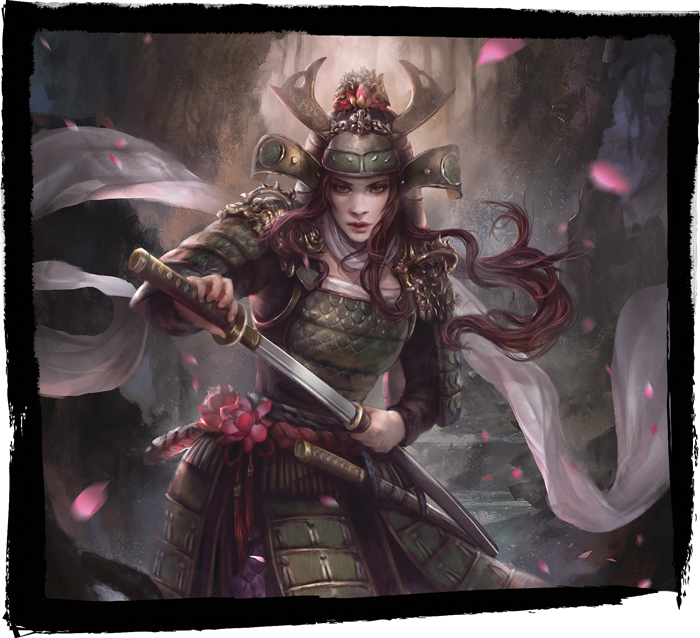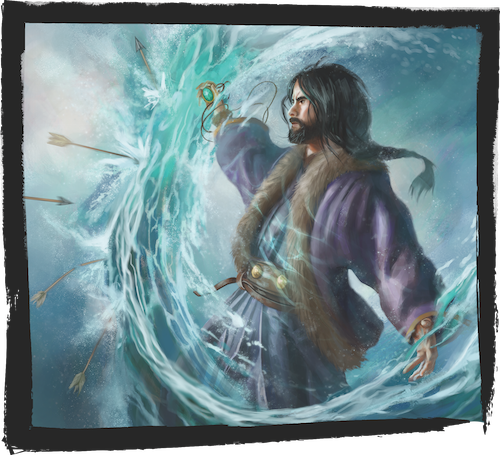Originating as a series chronicling David Gordon’s return to the Legend of the Five Rings CCG after a several year absence, Dave of the Five Rings continued on as he examined the current and future of the iconic world of Rokugan until the game’s sale to FFG in 2015.
Chapter 23: Through The Looking Glass
In a handful of days, the last two years of waiting for the community surrounding Legend of the Five Rings will finally be over. Twenty years of history led up to the celebration at Gen Con 2015, promising a new storyline for the venerable collectible card game, one with daring choices and shocking twists. The energy at the 20th Anniversary Celebration was the highest and most hopeful it had been in years for everyone involved.
And then September came, and the news of the sale of the Legend of the Five Rings brand to Fantasy Flight Games rocked us to our core.
In the two years that have followed, we have kept an eager vigil for the coming day when we might return to the land of Rokugan.
That day is right around the corner, and the Rokugan we are finding is different than the one we remember. Vast stretches of history have changed, and twenty years of storyline have been rolled back. A new card game, a Living Card Game (LCG), sits at the center of this familiar-yet-different Rokugan. Fantasy Flight Games has made the promise of launching their largest LCG line to date, treating Legend of the Five Rings as a flagship brand to be placed alongside their Arkham Horror, Star Wars, and Android lines.
With so much having been changed, however, can Fantasy Flight Games take one of the older and more troubled brands in tabletop gaming to new heights? Can the promise of Legend of the Five Rings succeed in a marketplace vastly different than the mid-90’s where it began? Will this be a rebirth for L5R, or the final nail in the coffin of a beloved game line?
Well, dear reader, you should already be able to guess where my hopes lie in this. And it is with the most cautious of optimism that I can say I believe Legend of the Five Rings under Fantasy Flight Games will succeed.
Speaking Of Absences
It has been a busy five months since April, hasn’t it? And where have I been during the slow but steady drip drip drip of new game info?
In a word, busy. Time and tide wait for no one, and neither do spoilers, reveals, and the gaming industry’s steady march. I have been able to only dip my toes into the community over the last few months, saying my pieces here and there, and encouraging discussion. My apologies for having been away for so long, but I wanted to wait for us to truly have a holistic view of the game to discuss before I stepped back into the fray. We have that now. And what we have is truly awesome.
First and foremost, I am pleased to confirm that my predictions when last we spoke have, by and large, proven to be true. In their very first post, Fantasy Flight Games confirmed several key details of Legend of the Five Rings that would be returning in the LCG. L5R would continue to be a game of the Great Clans of Rokugan, with seven distinct factions contesting for dominance in the courts and battlefields of the Emerald Empire.
Players would take on the role of one of these factions, shaping their deck around that faction and representing their Great Clan’s drive towards victory. And just as with the CCG version, the new LCG would feature a two deck set up, with a Dynasty deck containing your characters and holdings, and a Conflict deck containing your events and attachments (and some characters as well, in an interesting twist).
In this new iteration victory can be achieved along three separate paths, with Conquest, Honor, and Dishonor each providing a means to win. Enlightenment has been incorporated differently into the game, and the old Military victory has certainly been made altered as well, as we’ll get to.
Finally, built into the game itself is the dynamic back and forth action rhythm between players that was essential to the fun of the old school game, the sheer tactical exchange of a battlefield feeling more akin to a game of Chess than the stringing together of combinations common to other card games.
Still, even with these elements central to the L5R CCG surviving into the LCG, many design choices have been taken to create a fresh and fascinating approach to a game of magical samurai. The storyline has been reset back to prior to the events which eventually lead to the Clan Wars (which the original game began in the middle of). As such, the fan favorite factions of the Mantis Clan and the hotly contested Spider Clan have been removed from the game – at least for now – leaving only the original six factions, plus the Scorpion Clan.
Honor has also been overhauled, both as a mechanic and as a victory condition. The all-or-nothing aspect of winning opposed battles has been removed, with penalties added to players who refuse to send defenders. Politics has been introduced alongside Military power as means of conquering your opponent’s Provinces. The five Elemental Rings are now the stakes of your Conflicts, and will shake the progress of your game. And above all else, an entirely new system of resource has been introduced based on Fate and the progress of time, replacing Gold and economics.
That said, in many ways the LCG will succeed as being cosmetically similar enough to its CCG predecessor that someone in passing should still recognize it instantly as L5R, even while possessing a new gameplay model rooted in a much more modern design philosophy. It is a game which will look and feel like old L5R, but play like an entirely new beast.
So…How Does It Play?
Curious on a rundown of how the new L5R rules work? Then click below. Otherwise, read on!
Resources and stratagems are represented by their Dynasty and Conflict decks respectively. Their standing in the eyes of the Emerald Empire is shown by the number of Honor tokens they possess, and their ability to bring their resources to bear in this war is represented by a number of Fate tokens. The stakes of the battles between these rivals, as well as the means they will battle, are represented by the five Elemental Rings, the philosophical matter of which the world is made and understood. Each Elemental Ring contains a side for Military conflict and a side for Political conflict. Finally, the Imperial Favor is available to those who stand ready to bring Glory to their side, giving an edge in one of the areas of battle.
At the start of the game, each player shuffles Dynasty deck, their Conflict deck, and chooses five Province cards. Province cards are placed face down in front of each player: four between the Dynasty deck on the player’s left and the Conflict deck on the player’s right, and the fifth is placed in front of the Dynasty deck, with the player placing their Stronghold in that Province. Provinces serve as the site of Conflicts between the players, with the objective of ‘breaking’ the Province by overwhelming the combined strength of the Province and its defenders. Once a player has broken three of their opponent’s Provinces, only then can they declare a Conflict at the Province holding their opponent’s Stronghold. If you break the Province holding your opponent’s Stronghold, you win.
The Stronghold determines the player’s faction, along with their starting Honor tokens, Fate token generation, and their Influence score. Each Stronghold may also add a modifier to its Province’s Strength, and /or an Action to be taken during the game. Honor represents the player’s standing in the Empire; should a player reach 25 Honor tokens, they immediately win the game. Alternatively, if a player is reduced to 0 Honor, they immediately lose the game.
Each players Dynasty deck is constructed of Character cards and Holding cards. Characters represent warriors, diplomats, priests, and other people the player can recruit to aid them in their war. Characters can perform Actions and can be sent to Conflicts, either to break your opponent’s Provinces or protect your own.
Holdings are resources which remain in their Province, providing an Action and (typically) a boost to the Province’s Strength. Dynasty decks can only hold either Neutral cards or cards aligned with the player’s faction. All Characters also contain Military and Political skill, representing how powerful they are in Conflict, as well as their Fate cost. Essentially, the Fate cost of Character is how much must be paid to recruit them to your side during the first phase of the turn, the Dynasty phase.
Conflict decks are constructed of Event, Attachment, and Character cards. Cards from the Conflict deck provide the player with Actions and equipment for their Characters to sway the course of Conflicts, as well as Characters held in reserve as a surprise.
As with the Dynasty deck, the Conflict deck can only freely contain Neutral or in-faction cards, though a player may also include in their Conflict decks cards from one (and only one) other faction. Many Conflict cards have an Influence cost, and a player is cannot go above the Influence value on their Stronghold when constructing decks. Attachments and Events also have Fate costs. However, unlike the Dynasty cards these aren’t limited to being played during the Dynasty phase. Similarly, Conflict Character cards are not limited to being played during the Dynasty phase; some can even be played during fights.
At the start of the game, each player deals one Dynasty card to each of their four Provinces which do not contain their Stronghold and draws five Conflict cards. The first player is determined randomly. Both players reveal the cards in their Provinces, then receive the number of Fate tokens determined by their Stronghold. Starting with the first player and alternating, players take turns either using Actions on cards or paying Fate to bring Characters into play. The first player who passes in this process effectively ends their actions for the phase but receives 1 Fate as a bonus. Once both players pass, the first phase is over. Then things get interesting.
Each player picks up their Honor Dial, and secretly bids a number between 1 and 5. This number represents the number of Conflict cards they wish to draw that turn. Once both players have decided, their bids are revealed. The player who bid higher must give the difference in bids in Honor tokens to the player who bid lower. Then each player then draws a number of Fate cards equal to their bid.
Next, Actions can be played and Conflicts can be declared. Each player is allowed to declare up to two Conflicts per turn by taking an unclaimed Elemental Ring and placing it on an opponent’s Province. The player then decides if the Conflict will be Military or Political; players are limited to one Conflict of each type per turn.
To do this, the player must commit at least one Ready (unbowed) character to the Conflict as an attacker. The Province is revealed and the defending player chooses Ready characters to be defenders. Once both attackers and defenders are declared, players alternate back and forth with the opportunity to play an Action or until both players consecutively pass. Once that happens, each side totals up their corresponding Skill on Ready characters at the site, and whomever has the higher total wins the battle. The winner claims the Elemental Ring for the turn, and if the winner was the attacker, they may resolve its effects.
Each Ring provides a different reward. The Ring of Earth allows you to draw a card and force your opponent to discard a card. The Ring of Water readies a Character you control. The Ring of Air gains you 2 Honor tokens or lets you take 1 Honor token from your opponent.
In addition, if the attacking player wins and has their total attack strength exceeds the defending player’s total, the Province is broken.
Once all players have resolved any Conflicts, the Conflict phase ends. Players total up the number of Elemental Rings they claimed plus the amount of Glory (a trait on Characters which may modify their Skill) on Ready characters. Whomever has the highest total gains the Imperial Favor. This manifests as a +1 to their Skill totals in either Military or Political Conflicts.
After Conflict resolves, the turn is finished by removing any Characters without Fate tokens on them; all remaining Characters lose a Fate. As such, characters in L5R LCG are transient at best, with a very high turnover rate. Simply put, nothing lasts forever in L5R LCG, and the Fate mechanic very much embraces this.
[/spoiler]
Gen Con 2017 and Kiku Matsuri
Gen Con 2017 sees the triumphant return of Legend of the Five Rings, and Fantasy Flight Games is pulling out all the stops to make it a celebration worth remembering. It begins with the Kiku Matsuri on Thursday, a literal parade from outside the convention center into the Expo Hall, before they begin with the very first tournament of the game. Friday sees the second tournament, with finals on Saturday and a casual tournament on Sunday. A voice in a storyline choice will be available for those who go undefeated on Thursday, and those who place in the top of their Clans on Friday and Saturday will be able to influence the direction of their Great Clan in the storyline, leading up to the World Championships in November.
For those who intend to participate, I will see you there in my full Spider Clan regalia. We may no longer be a faction in the game, but the Spider Clan community has remained as thick as thieves in the off-season of the last two years. We will make our return alongside the game this Gen Con, and we will stand shoulder to shoulder with the other Great Clans and proclaim our glory for all to see! If you won’t be attending Gen Con in person, look for coverage on the Fantasy Flight Games Facebook page, as they will be live-casting it out to the internet.
While there is so much more for me to write about today, dear reader, I must confess the hour has grown late and this article has grown long. Look for me in the coming weeks as I write about their upcoming plans for Organized Play, as well as how the Great Clans have changed conceptually, interspersed with my own experiences at the inaugural events at Gen Con.
If you are among the fortunate at the convention, and you see the tall ginger with the big Spider Clan symbol on his vest, feel free to say hi. I will be happy to meet you at long last, and I will be proud to stand at your side as they call for us to show our honor.
Utz!
BANZAI!
L5R has returned.

David Gordon was a regular contributor to the site. A storyteller by trade and avowed tabletop veteran, he also has a long and complicated past with L5R. These were his stories. He can be reached on Twitter.
You can discuss this article and more on our social media!
Photo Credits: Legend of the 5 Rings images by Fantasty Flight Games.

